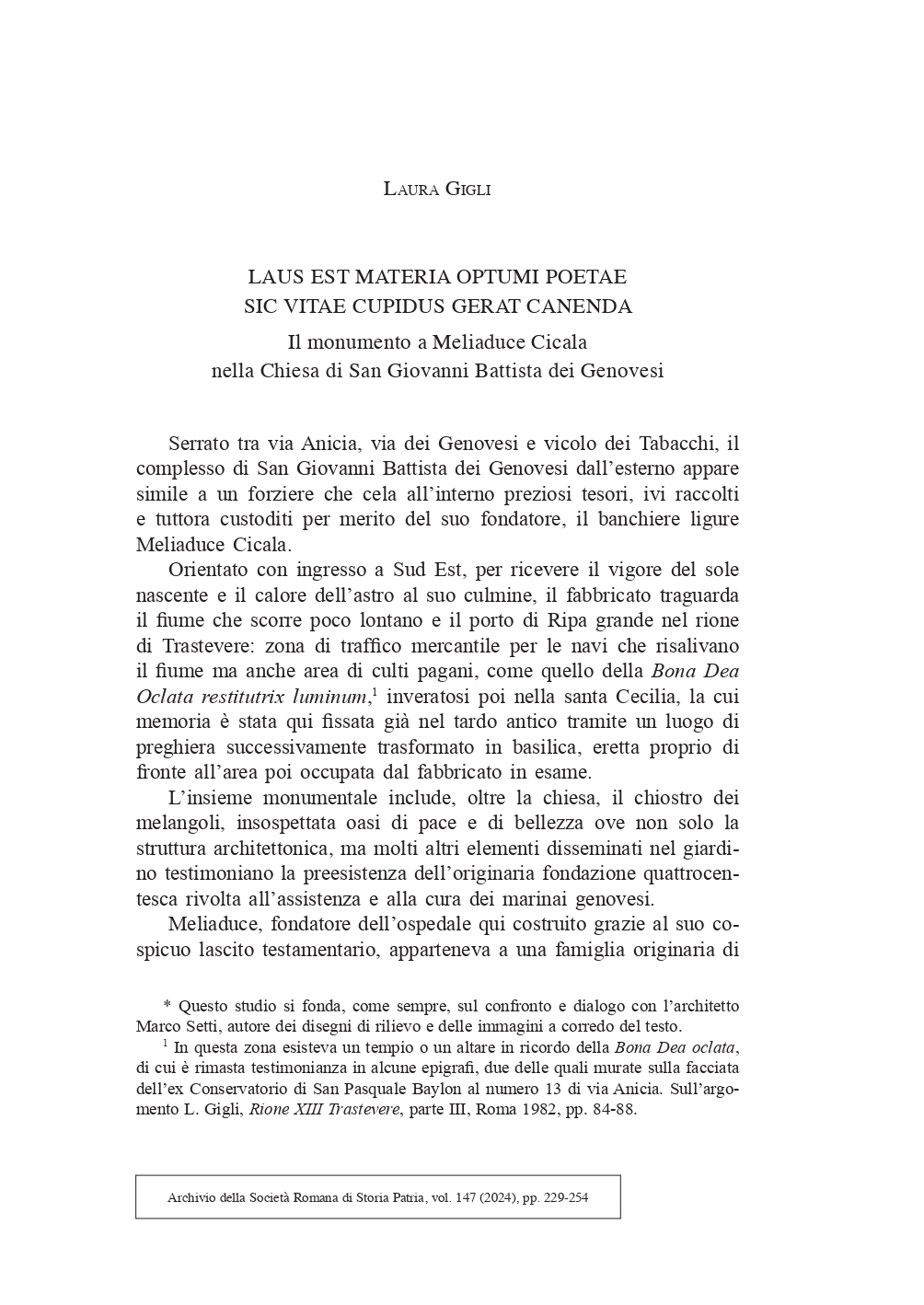Archivio della Società romana di storia patria vol. 147/I (2024) 10 – GIGLI
6,00€
Codice DOI: 10.61019/ASRSP_147_I_10
File formato PDF
Laura Gigli
LAUS EST MATERIA OPTUMI POETAE / SIC VITAE CUPIDUS GERAT CANENDA
Il monumento a Meliaduce Cicala nella Chiesa di San Giovanni Battista dei Genovesi
Lo studio esamina il programma culturale di Meliaduce Cicala (1430-1481), fondatore dell’Ospedale di San Giovanni Battista dei Genovesi, fissato nel suo monumento funebre, e lo stringente nesso della sua primitiva collocazione con l’originaria struttura architettonica della chiesa trasteverina. Le figurazioni della decorazione commettono tra loro le varie parti dell’opera con precisi accorgimenti formali e l’iconografia, specie nel caso delle figure santorali, è in linea con le istanze più avanzate della cultura del tempo. Lo spostamento del monumento, a seguito del restauro della chiesa di San Giovanni Battista dei genovesi del 1864, sulla parete di NE dell’edificio, ne ha reso più problematica la lettura, che invece nella sua originaria posizione (sul lato opposto) riverberava correttamente la simbologia adombrata dal Battista, dall’Evangelista e dallo stesso defunto rivolto, al pari dell’apostolo, alla luce del nuovo giorno, come nei monumenti funebri etruschi, nell’attesa del risveglio. Il distico commemorativo del Cicala pone a specchio, l’uno di fronte all’altro, l’ignoto poeta e lo stesso Meliaduce, la cui opera ha consentito la realizzazione di «cose da celebrare» che ne perpetuano l’esistenza tra i vivi e ne tramandano in modo imperituro la memoria. La formalizzazione dei contenuti espressi nel monumento è da riferire ad Andrea Bregno – ideatore di questa tipologia architettonica – e alla sua bottega, che includeva gli scultori più prestigiosi del tempo presenti a Roma.
LAUS EST MATERIA OPTUMI POETAE / SIC VITAE CUPIDUS GERAT CANENDA. The monument to Meliaduce Cicala in the Church of San Giovanni Battista dei Genovesi
The study examines the cultural program of Meliaduce Cicala (1430-1481), founder of the Hospital of San Giovanni Battista dei Genovesi, embedded in his funerary monument, and the intimate connection between its initial location and the original architectural structure of the Trastevere church. Precise formal alignments between the figural elements of the decoration once united the monument’s various components, while the iconography, especially that of the sacred figures, was in line with the most advanced cultural demands of the time. The relocation of the monument following the church’s 1864 restoration to a position on the northeast wall of the building disrupts our understanding of its meaning, for its original position on the opposite wall permitted the symbolism prefigured by the Baptist and the Evangelist to reverberate to the deceased himself who turned like the apostles toward the light of the new day, while also, as in Etruscan funerary monuments, awaiting reawakening. Cicala’s commemorative couplet places, in mirror reflection, the unknown poet and Meliaduce, whose work allowed the creation of «things to celebrate» that perpetuate his existence among the living and transmit his memory eternally. The rendering into visual form of the ideas expressed in the monument is to be ascribed to Andrea Bregno – creator of this architectural typology – and his workshop, which included the most prestigious sculptors then active in Rome.
Archivio della Società romana di storia patria, 147/I
dicembre 2024, pp. 26


